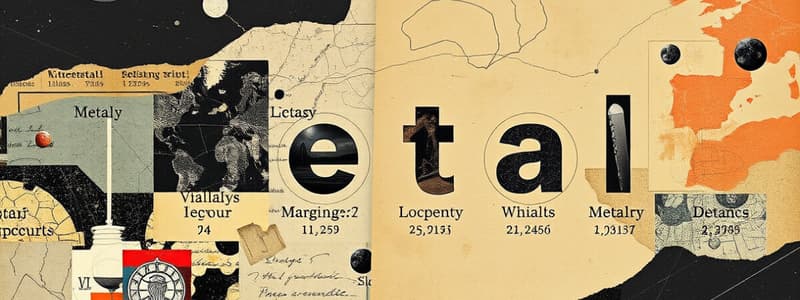Podcast
Questions and Answers
What property of metals is primarily responsible for their shiny appearance?
What property of metals is primarily responsible for their shiny appearance?
- High boiling point
- Electrical conductivity
- Metallic luster (correct)
- Malleability
Which of the following metals is known for its high electrical conductivity and is commonly used in wiring?
Which of the following metals is known for its high electrical conductivity and is commonly used in wiring?
- Tin
- Lead
- Copper (correct)
- Iron
What characteristic allows metals to be shaped into thin sheets without breaking?
What characteristic allows metals to be shaped into thin sheets without breaking?
- Malleability (correct)
- Solubility
- Ductility
- Brittleness
What is the reason for the high melting and boiling points of metals?
What is the reason for the high melting and boiling points of metals?
In which part of the periodic table are metals typically located?
In which part of the periodic table are metals typically located?
What typically happens when metals react with acids?
What typically happens when metals react with acids?
Which of the following is a common property of metals?
Which of the following is a common property of metals?
Which of the following properties is NOT characteristic of nonmetals?
Which of the following properties is NOT characteristic of nonmetals?
What property makes metals suitable for being drawn into wires?
What property makes metals suitable for being drawn into wires?
In terms of reactivity, how do metals behave in the periodic table?
In terms of reactivity, how do metals behave in the periodic table?
Which metal has one of the highest melting points, at 3422°C?
Which metal has one of the highest melting points, at 3422°C?
What allows free electrons in metals to carry energy and electrical charge?
What allows free electrons in metals to carry energy and electrical charge?
Which statement about nonmetals and their oxides is true?
Which statement about nonmetals and their oxides is true?
Which of the following statements is NOT true about metals?
Which of the following statements is NOT true about metals?
What is true about the ionization energy of metals compared to nonmetals?
What is true about the ionization energy of metals compared to nonmetals?
Why do nonmetals exhibit poor conductivity?
Why do nonmetals exhibit poor conductivity?
Which of the following metals is known for its high density?
Which of the following metals is known for its high density?
What is the typical characteristic of metals in terms of electronegativity?
What is the typical characteristic of metals in terms of electronegativity?
What happens when sodium reacts to form a cation?
What happens when sodium reacts to form a cation?
Which nonmetal is commonly used in water treatment processes?
Which nonmetal is commonly used in water treatment processes?
Flashcards are hidden until you start studying
Study Notes
Metals
- Metals occupy the left and center regions of the periodic table.
- Characterized by shiny appearance known as metallic luster, due to free-moving electrons reflecting light.
- Excellent conductors of heat and electricity, with copper and aluminum being prime examples.
- Malleable and ductile; can be hammered into sheets or drawn into wires while maintaining structure.
- High melting and boiling points, attributed to strong attractions between metal cations and delocalized electrons; tungsten has a melting point of 3422°C.
- Generally high density; lead has a density of 11.34 g/cm³.
- React with oxygen to form oxides; for example, iron and oxygen create iron oxide (rust).
- React with acids to yield hydrogen gas and salts; zinc and hydrochloric acid produce zinc chloride and hydrogen.
- Tend to lose electrons forming positively charged ions (cations), exemplified by sodium forming Na⁺.
Nonmetals
- Found on the right side of the periodic table; properties are often the opposite of metals.
- Lack metallic luster; most appear dull and do not reflect light.
- Poor conductors of heat and electricity due to absence of free-moving electrons; sulfur and phosphorus exemplify this.
- Typically brittle when solid, breaking rather than deforming; sulfur crystals are a common example.
- Lower melting and boiling points compared to metals; graphite carbon melts at 3652°C, iodine at 113.7°C.
- Generally lower densities; gases like hydrogen and helium have very low densities.
- React with oxygen to form acidic oxides, such as carbon yielding carbon dioxide (CO₂).
- Can react with bases to form salts and water, demonstrated by sulfur dioxide with sodium hydroxide.
- Tend to gain electrons to form negatively charged ions (anions); chlorine forms Cl⁻.
Periodic Trends
- Metals typically have low electronegativity, with levels increasing left to right and decreasing down a group.
- Have low ionization energies which increase across periods and decrease down groups, facilitating cation formation.
- Reactivity in metals generally increases down a group; alkali metals like potassium are highly reactive.
- Nonmetals possess high electronegativity values, attracting electrons strongly; this trend mirrors that of metals.
- Nonmetals have high ionization energies, resisting electron loss; this also follows the periodic trend.
- Reactivity in nonmetals generally decreases down a group; for instance, halogens are more reactive than noble gases.
Practical Applications
- Metals are crucial in construction (steel, aluminum), electronics (gold, silver, copper), and the automotive industry (iron, steel).
- Nonmetals play key roles in water treatment (chlorine for disinfection), medicine (iodine, fluorine in antiseptics), and agriculture (nitrogen and phosphorus in fertilizers).
- Understanding properties of these elements aids predictions in chemical interactions and applications in various sectors.
Studying That Suits You
Use AI to generate personalized quizzes and flashcards to suit your learning preferences.




